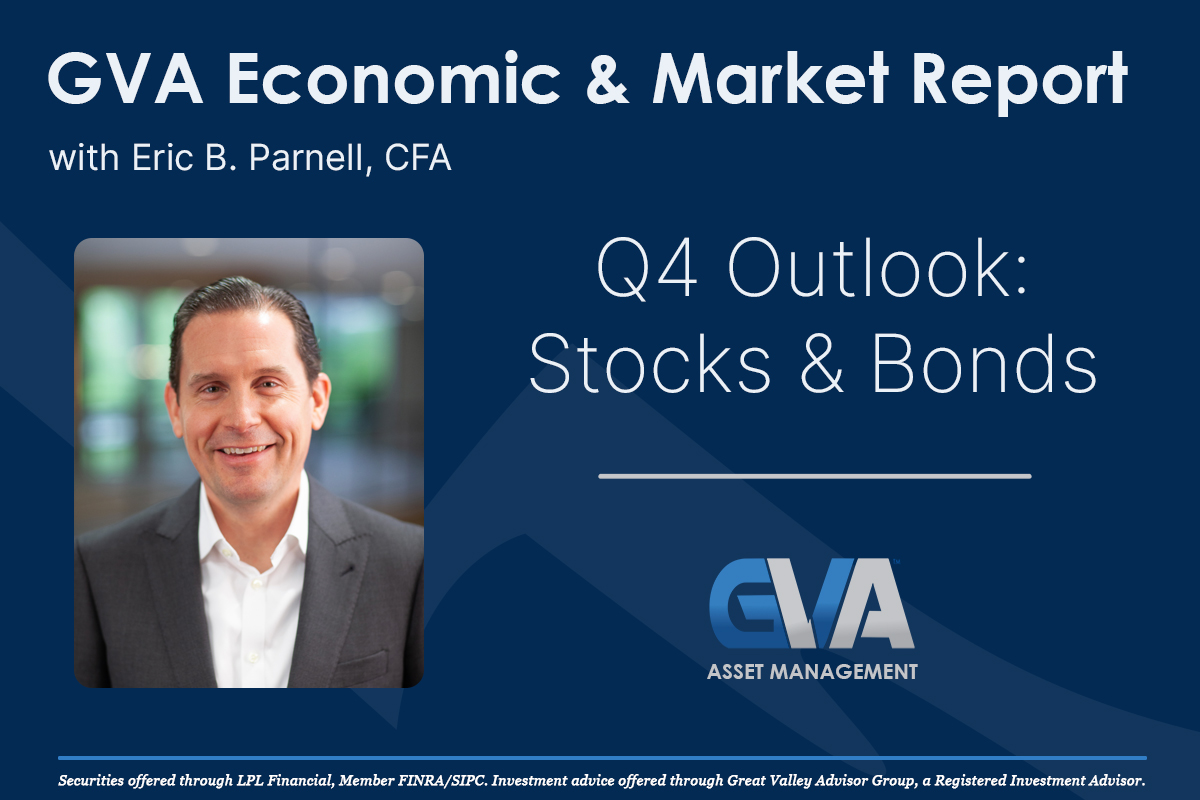
It has been an interesting and eventful year so far. Heading into 2023, it was widely expected that the U.S. was headed toward recession and that the equity markets would face continued volatility amid the uncertain economic outlook. But in the nine months since, we’ve seen a resilient U.S. economy that continues to grow at a healthy rate and a U.S. stock market that has advanced by double-digits year to date. Nonetheless, the markets are still not without meaningful risks as evidenced by stock and bond market performance over the last couple of months. As a result, it is worth exploring what we might reasonably expect from capital markets as we move through the final three months of the calendar year.
Stock flight turbulence. Stocks have been in an extended period of consolidation as we enter the fourth quarter. After peaking at just over 4600 on the S&P 500 following a furious summertime rally during June and July, the headline benchmark index has retreated by more than -6% since the end of July through late September. While this is certainly a notable and measurable pullback, it is also important to put it in context.
First, a period of stock consolidation was long overdue. For example, the S&P 500 was already marginally higher year to date and nearly +10% above the October 2022 lows in the immediate aftermath of the banking crises that felled Silicon Valley Bank and Credit Suisse among others in mid-March. Yet during the subsequent period from mid-March through the end of July, the S&P 500 Index jumped nearly +20% further.
In the process the market was trading way above trend by mid-summer. Consider the chart below. At 4607 at the end of July, the gap between the S&P price, its medium-term 50-day moving average (blue line), and its long-term 200-day moving average (red line) had become notably wide. Thus, the pullback we have seen over the last two months at least to this point has been nothing more than a stock market regressing to its mean longer-term trend. The good news is that this trend remains definitively higher as evidenced by the green trendline in the chart. And following the latest lurch to the downside in late September, stocks have now arrived at upward sloping trendline support.
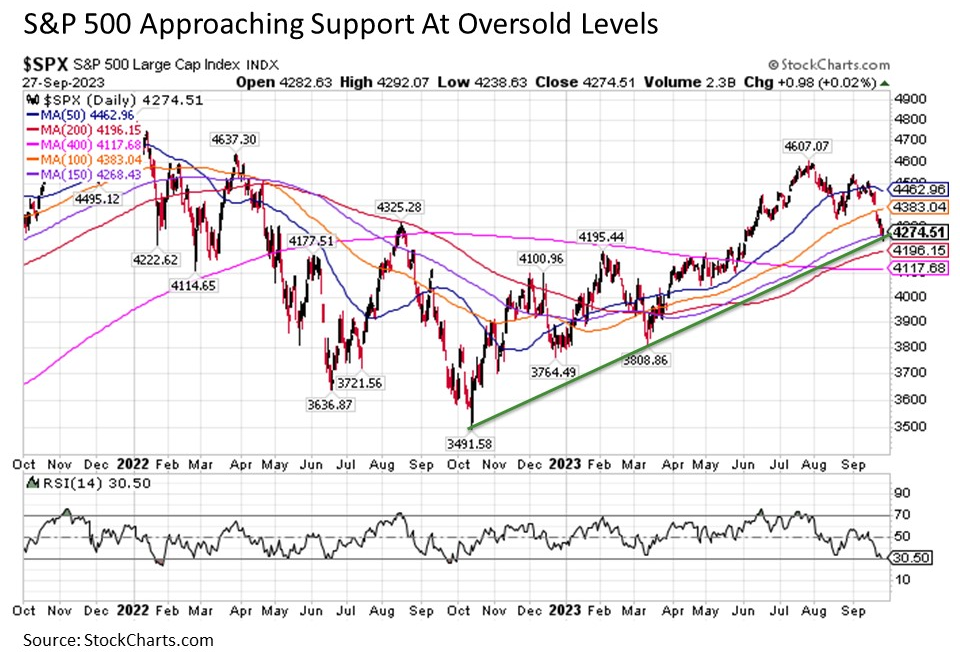
The constructive view that stocks may have worked off recent froth and are now oversold is supported by U.S. small caps. While the bounce off the October 2022 lows has been much more subdued among smaller company stocks, the pullback since late July has also brought the S&P 600 Small Cap Index back to its upward sloping trendline.
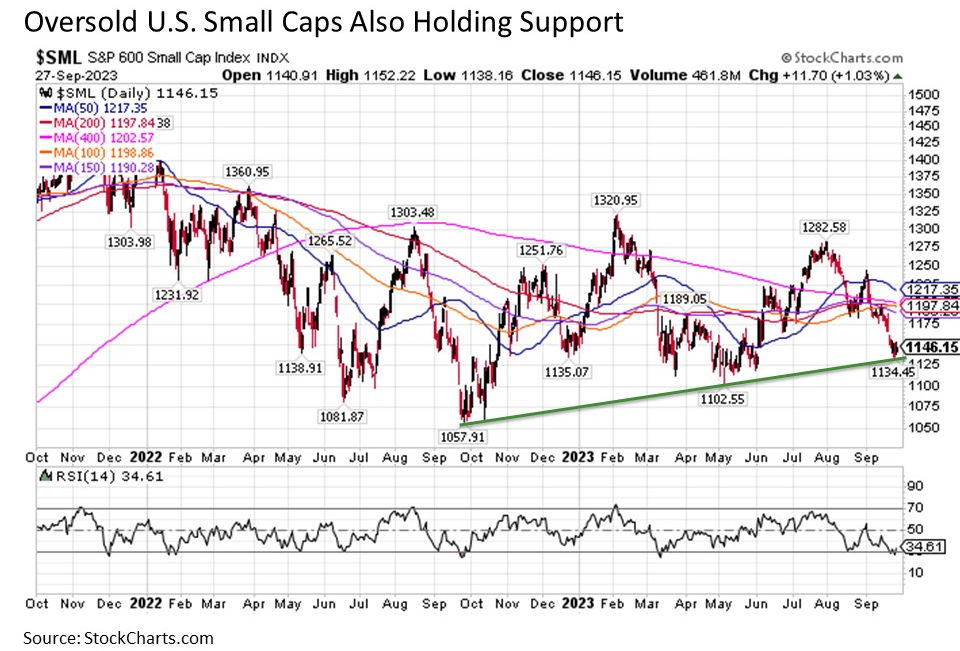
With underlying annual corporate earnings on the S&P 500 that have rebounded by roughly 10% from their 2022 Q4 lows with underlying profit margins having expanded by nearly a percentage point over the same time period, stocks have been receiving increased fundamental support behind the advance since the start of the year. And while valuations may be stretched on a headline basis, when one excludes the mega cap Magnificent Seven stocks of Apple, Microsoft, Amazon, Meta Platforms, Alphabet, NVIDIA, and Tesla that have been the primary drivers of stock market returns year to date, we have a broader market that is trading at a far more reasonable multiple just above 18 times earnings that is more in line with the long-term historical trend over the past 35 years.
Stocks bottom line for 2023 Q4: Putting this all together, the outlook for stocks remains favorable through the end of the year. While the potential for further volatility should be expected as we make our way through the historically turbulent period through mid-November, the upside potential for stocks is now more constructive in the wake of the recent pullback that has provided a healthy consolidation, particularly if the trend in corporate earnings and profit margins continues through the latest corporate earnings season. This will be a key to watch in the coming weeks.
Bond yields running hot. Beyond the consolidation in stocks, the recent pain in the bond market has been even more pronounced. After what had been a solid year for bonds through May, sledding has become far more challenging in the months since. After bottoming at 3.37% in the mid-spring, the 10-Year U.S. Treasury yield has jumped more than 125 basis points to over 4.60% as the third quarter draws to a close. Not only is this a breathtaking move in the typically staider bond market, we are now more than 35 basis points above the previous cycle high on the 10-Year U.S. Treasury yield at 4.25% from last October.
Given the recent blistering rise in Treasury yields, what should we expect from bonds as 2023 draws to a close. The good news is that the bond market in general and the U.S. Treasury market in particular are providing us with a variety of reasons to be constructive for the upcoming quarter despite the recent challenges.
First, much like the stock market at the end of July, the recent jump in bond yields has gotten to be a bit much as of late (refresher: as bond yields rise, bond prices fall). Consider the chart below, where today’s 10-Year U.S. Treasury yield at over 4.6% and rising is now well above its medium-term 50-day moving average (blue line) and long-term 200-day moving average (red line). We saw similar wide gaps in the summer and fall of 2022, and in both instances, Treasury yields eventually regressed to the mean with bond yields falling back to trend. So even if U.S. Treasury yields continue to rise to 5% or beyond in the long-term, they are now overdue to fall back toward their trend range between 3.75% to 4.25% in the near-term along the way.
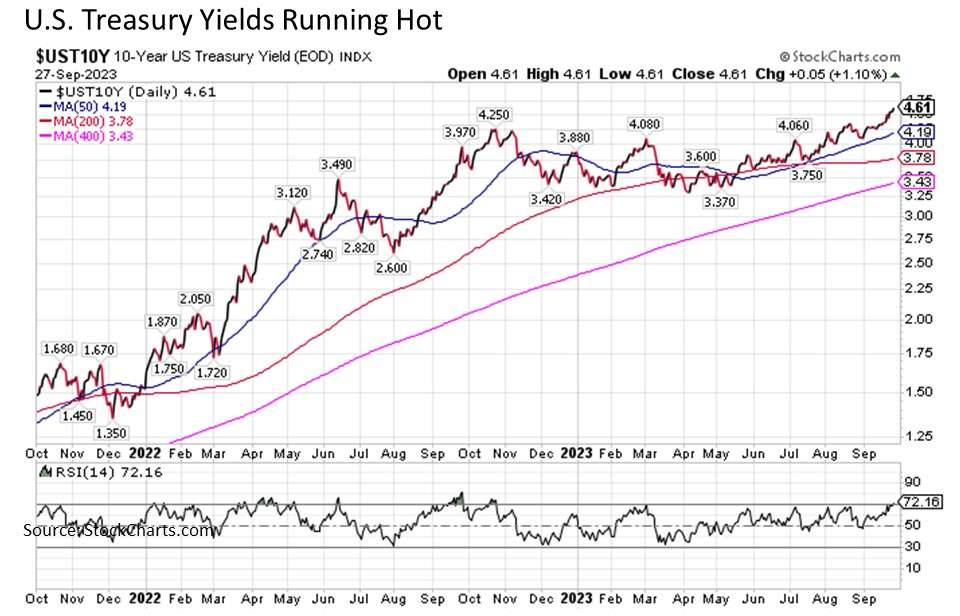
Next, while it is certainly possible that the 10-Year U.S. Treasury yield could continue to rise toward the 4.75% to 5.00% range or beyond in the coming weeks, the underlying fundamentals do not support the sustainability of such a move. Yes, the U.S. Treasury continues to increase the supply of bills, notes, and bonds that it is issuing into the marketplace, but the supply of bonds has never been a statistically significant determinant of the quoted interest rate on bonds throughout history. Check with the investor in Japanese government bonds over the last few decades for confirmation on this point. And while bond buyers may be understandably jittery about the inflation outlook given the recent spike in oil prices, we should continue to remember two things. One, oil prices have indeed spiked since earlier this year, but they are still -37% below their all-time nominal peak from more than 15 years ago before the Great Financial Crisis and -28% below their peaks from early last year. While oil prices may indeed continue to rise back well above $100 per barrel in the coming months – the fundamentals support such a move – this does not mean that scorching inflation is coming back. After all, if high oil prices meant we were getting higher inflation, we would have had a heck of an inflation problem over the past two decades. Except we didn’t. Two, oil prices much like food prices are not part of the core inflation readings. And while headline inflation might be ticking back higher, core inflation is continuing to trend lower, albeit more gradually than before.
Standing back and looking at the forest instead of the trees, we see that while the notion of a renewed rise in inflation is getting a lot of chatter in the financial media, the reality remains that inflation expectations remain as subdued as ever based on market prices according to the 5-year breakeven inflation rate that continues to hover in the 2.25% range.
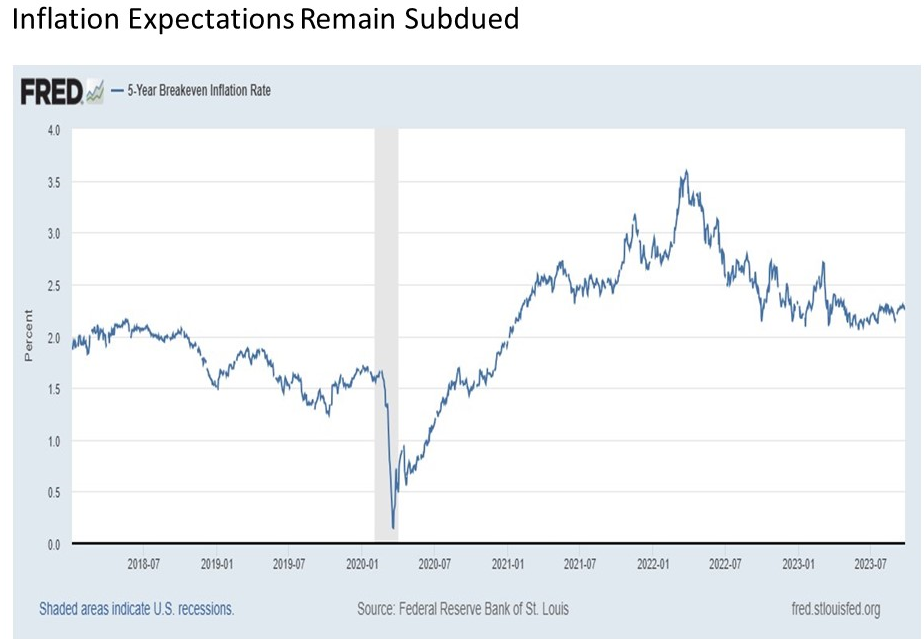
This may also help to explain that while we’ve heard a lot of handwringing about the potential for one more quarter point rate hike from the U.S. Federal Reserve emerging from their latest September FOMC meeting, the actual probability for such a move by the Fed at any of their next three meetings in November, December and January has actually fallen from well over 50% to just over 40% over the past month according to the CME FedWatch Tool. In other words, while the chatter about one more Fed rate hike has recently increased, the actual market pricing on such an outcome has not only decreased but moved further out into 2024.
Bonds bottom line for 2023 Q4: Putting this all together, investors have good reason to be even more constructive on bonds than stocks as we make our way through 2023 Q4. Could the 10-Year U.S. Treasury yield continue to rise toward 5% in the coming weeks? Sure. But bond yields are overdue to fall back lower in the short-term and fundamentals support a more sustained move lower in the longer term.
Overall bottom line. It has been a tough stretch for both stocks and bonds in recent months. But in a healthy functioning market, we can see extended periods of consolidation if not outright weakness. And such are the periods that provide investors with attractive entry points for longer term total return opportunities. As we enter 2023 Q4, the good news is that both stocks and bonds are offering such a set up as we make our way through the final three months of the year.
Disclosure: I/we have no stock, option or similar derivative position in any of the companies mentioned, and no plans to initiate any such positions within the next 72 hours. I wrote this article myself, and it expresses my own opinions. I am not receiving compensation for it. I have no business relationship with any company whose stock is mentioned in this article. Investment advice offered through Great Valley Advisor Group (GVA), a Registered Investment Advisor. I am solely an investment advisor representative of Great Valley Advisor Group, and not affiliated with LPL Financial. Any opinions or views expressed by me are not those of LPL Financial. This is not intended to be used as tax or legal advice. All performance referenced is historical and is no guarantee of future results. All indices are unmanaged and may not be invested into directly. Please consult a tax or legal professional for specific information and advice.
Tracking #485090-1
